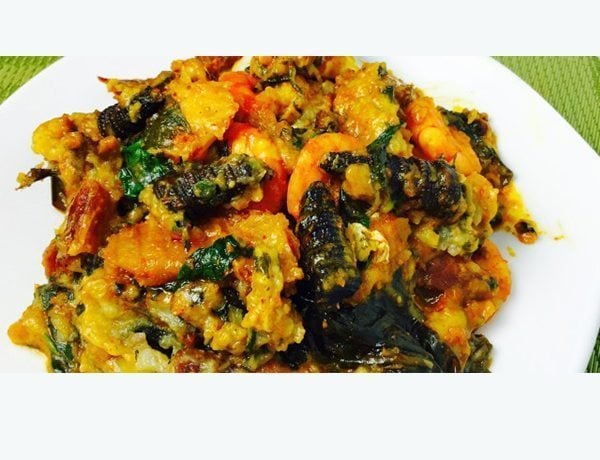Nigeria’s Healthiest Meals: Ekpang Nkukwo – Cultural Background, Exclusive Recipe & Health Benefits

At Style Rave, we aim to inspire our readers by…
I
t has been said that one of the main aspects of a culture is food. Whatever type of meal it is, the raw state, the method used to prepare it, the type of occasion where it is served and how it is served all define the cultural relevance of such a meal.
Nigerian cuisine is as diverse as its people. Each region has its specialty meals which they are known for. Akwa Ibom state which lies in the southernmost part of the country has her traditional diet predominantly made of vegetables, seafood and meat. Common dishes of the Akwa Ibomities include Afang, Edikan Ikong soup, Brassas (Bitter leaf) soup, Atama soup, Editan soup, Egusi soup, Afia efere ebot (white soup), all served with garri, pounded yam or fufu. Porridges include; Yam, Plantain, Maize and Ekpang Nkukwo (Cocoyam).

Growing up in a traditional Nigerian Akwa Ibom setting gave me the opportunity to first enjoy as a child and later as an adolescent learn how to make these meals. My mother would always say that it is a taboo to eat a meal you don’t know how to prepare. So in order to enjoy all these delicacies, I had to painstakingly learn how to prepare every meal I liked and I liked every meal. Don’t judge me!
One of my favourite meals is Ekpang Nkukwo (cocoyam porridge), a traditional delicacy of the Efiks and Ibibios. The Ijebu’s prepare something similar called “Ifokore”. The methods of preparation are almost similar with a slight distinction in the way the Efik/Ibibios make the meal using “Nkukwo leaves” which is the leaves from the cocoyam plant. Ekpang Nkukwo is made with cocoyam as the main ingredient and a little water yam added to the cocoyam. It requires other ingredients like crayfish, fish, palm oil and periwinkle to give it it’s distinctive taste. Ekpang Nkukwo is well-loved by Efiks/Ibibios and everyone who’s ever tasted it. It is mostly served at traditional marriages in a traditional, wooden and covered mini-pot.
As a former restaurant owner, I had the pleasure of sharing my special Ekpang Nkukwo recipe with many of my customers who became addicted to the meal after first tasting it.
Today, I am sharing with you all my exclusive recipe on how to make the coveted meal.
Ekpang Nkukwo Recipe
Prep time: 30 mins
Cook time: 25 mins
Total time: 55 mins

Ingredients
4 tubers of cocoyam
1 small water yam
Cocoyam leaves
Periwinkle
500 ml of palm oil
Habanero pepper
Dried fish
Stock fish
1 cup of cray fish
Handful of clove basil (Ntong)
4 cubes of seasoning cubes
Salt to taste
Cow hide (ponmo) diced into small bits

Preparation
1 Put some oil to cover the base of the pot to be used.
2 Boil some water in a kettle.
3 Using a grater, grate the cocoyam and water yam in a clean bowl and knead thoroughly to ensure the cocoyam and water yam is well mixed. Set it aside.
4 Shred the cocoyam leaves removing the veins from the leaves to allow for easy wrapping. Wash thoroughly and set aside.
5 Wash the perewinkles,basil cloves and cowhides to be used. Dice the cow hides into small cubes, shred the basil cloves.
6 Pour the periwinkle into oil based pot.
7 Using the fingers scoop small quantity of mix and wrap in the shredded cocoyam leaves. Repeat this process until the mix is exhausted.
8 Place the wrapped mix carefully in the oil based pot then add the crayfish, stock fish, dray fish, seasoning cubes, pepper, diced cowhide and salt to taste. Do not stir.
9 Pour the boiled water to the level of the wrapped mix.
10 Place the pot on the cooker and allow to cook slowly. Do not stir to avoid it from getting burnt.
11. Allow to cook for about 15 mins or once you notice the green leaves are turning brown, taste to for salt and seasoning.
12. Add the shredded basil cloves.
13. Add more palm oil and allow to cook for 5 mins.
14. Once the palm oil is cooked, turn off cooker.
Serve hot!
Health benefits:
Cocoyam which is the main ingredient of this meal is very rich in vitamin B6 and magnesium. The leaves are a good source of vitamins A and C and contain more protein than the corms. It also contains thiamine, calcium, niacin, manganese, vitamin B, vitamin C, vitamin E, magnesium, copper and riboflavin. Consuming nutrient-packed foods like cocoyam is vital for maintaining a healthy immune system, which helps our body to make use of protein, carbohydrates and other nutrients in the food we eat. Dietary fiber maintains a healthier digestive process and helps in the easy passage of stool.
Written by Uduak Ukpong
Photo credit: Mybelledonfull, Southpawgroup, Dooneyskitchen
At Style Rave, we aim to inspire our readers by providing engaging content to not just entertain but to inform and empower you as you ASPIRE to become more stylish, live smarter and be healthier. Follow us on Instagram! @StyleRave_ ♥




